Questões sobre Interpretação de Texto
Lista completa de Questões sobre Interpretação de Texto para resolução totalmente grátis. Selecione os assuntos no filtro de questões e comece a resolver exercícios.
Jeremy Harmer says that: "
The use of videotapes has been a common feature in language teaching for many years(...). To some people videotape is merely a glorified version of audiotape (...). But there are many reasons why video can add a special, extra dimension to the learning experience (...). One of the main advantages of video is that students do not just hear language, they see it too. Thus we can observe how intonation can match facial expression (...). Video uniquely allows students a look at situations far beyond their classrooms. This is especially useful if they want to see, for example, typical British 'body language' when inviting someone out (...)". (p.282). The best alternative is:
- A.
Videos are not essential in the classroom as they are "merely a glorified version of audiotape, and the use of video in class is just listening 'with pictures'.
- B.
Paralinguistic features, such as intonation, make it difficult for the learner to deeply interpret texts.
- C.
The use of video activities has just been implemented in the classroom.
- D.
When showing a video, it is not important to call the student's attention to cultural behaviour.
- E.
Showing videos in class is particularly important if the teacher wants to raise his/her students' cross-cultural awareness to things such as 'the body language' used by native speakers.
When considering learner autonomy and teacher development, Jeremy Harmer says that:
"However good a teacher may be, students will never learn a language or anything else unless they aim to learn outside as well as during class time. This is because language is too complex and varied for there to be enough time for students to learn all they need to in a classroom. (...) As David Nunan suggests, not everything can be taught in class (Nunan 1988a:3), but even if it could a teacher will not always be around if and when students wish to use the language in real life (Cotterall 1995:220).
To compensate for the limits of classroom time and to counter the passivity that is an enemy of true learning, students need to develop their own learning strategies, so that as far as possible they become autonomous learners. This does not always happen automatically. Attitudes to self-directed learning are frequently conditioned by the educational culture in which students have studied or are studying (...)" (p.335). We can infer that:
- A.
teachers will always encounter passive resistance if they attempt to impose self-directed learning inappropriately;
- B.
depending on the cultural context the student finds himself/herself in, autonomy of action is not always considered a desirable characteristic;
- C.
students will be equally successful as autonomous learners because learning styles do not vary;
- D.
even the less enthusiastic learner is likely to continue studying on his/her own after the course has finished;
- E.
if a student signs a 'learner contract' with his / her teacher, he / she will learn everything during class time.
Read the following passage and choose the option that best answers the questions 01 to 05.
"The amount of time it takes" (line 12) to master a new structure is related to:- A. the learner's previous exposure to that structure;
- B. the teacher's ability to link forms to their stylistic use;
- C. the teacher's ability to expose structures as a progressive process;
- D. the learner's accuracy in formulating hypotheses;
- E. the learner's ability to link forms to functions.
Read the following passage and choose the option that best answers the questions 01 to 05.
"The experienced teacher" (lines 23-24):- A. will not be too worried if a pupil starts to make errors in a previously taught grammar item;
- B. understands that the learning process is predictable;
- C. will wait for their pupils to master a certain structure if it has been accurately exposed;
- D. will induce their students to provide information about the communicative use of language structures;
- E. disregards contextualization of grammar structures.
Read the following passage and choose the option that best answers the questions 01 to 05.
"Learners" (line 20):- A. must refer to their mother tongue when testing hypotheses;
- B. acquire grammatical knowledge little by little;
- C. learn better if they learn inductively;
- D. only master a structure if they have an insight about it;
- E. contextualize structures when they write stylistic texts.
For questions 21-24 below, choose the answer which best fits the ideas in the text. 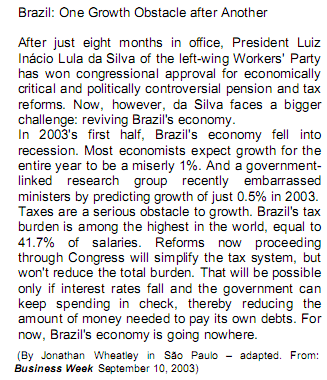
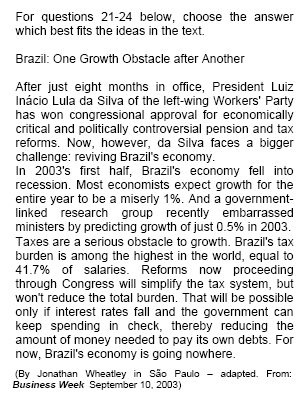
The picture of the current Brazilian economy given by this article is
- A.
highly optimistic.
- B.
guardedly hopeful.
- C.
unremittingly positive.
- D.
faintly negative.
- E.
distinctly bleak.
Read the following passage and choose the option that best answers the questions 01 to 05.
One of the aims of teaching grammar:- A. seems to be making learners stop making errors;
- B. has to do with the speed of the learning process
- C. seems to be informing the learners about the communicative use of language structures;
- D. has to do with sociolinguistics;
- E. has been in question for the past few years.
For questions 25-27 below, choose the answer which best fits the ideas in the text.
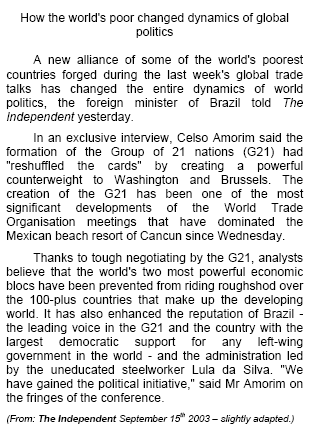
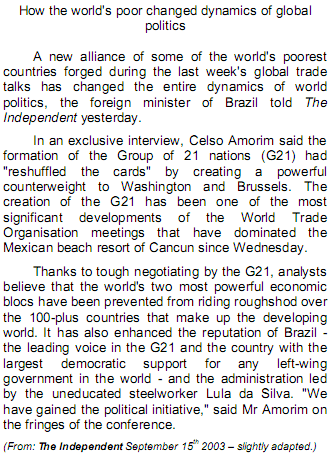 According to the text, G21 is a group involved in trade talks, and it aims to
According to the text, G21 is a group involved in trade talks, and it aims to
- A.
bring up new trump cards in Mexico negotiations.
- B.
offset the bargaining power of the USA and the EU.
- C.
shore up the power of the WTO to do deals.
- D.
lead over 100 countries to victory in the talks.
- E.
enhance the power of Brazil internationally.
For questions 25-27 below, choose the answer which best fits the ideas in the text.
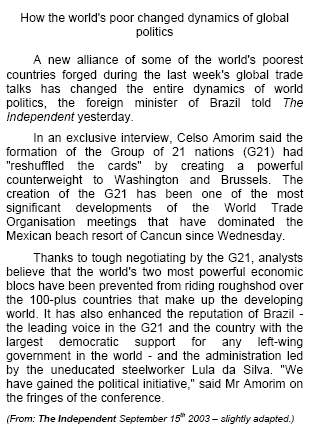

In relation to Brazil, the G 21 is expected to
- A.
reinforce the President's left-wing tendencies.
- B.
override national decisions of smaller powers.
- C.
make it the leading voice in the WTO.
- D.
leave it on the fringes of the conference.
- E.
bring additional prestige to the country.
For questions 21-24 below, choose the answer which best fits the ideas in the text. 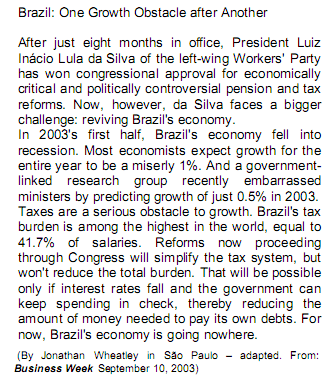
According to the text, a think tank recently caused the government some embarrassment by predicting
- A.
lower growth than most other economists had forecast.
- B.
cynicism over the government's tax reform program.
- C.
one of the highest tax burdens in the world.
- D.
stubbornly high interest rates for bank loans.
- E.
further cuts in the national interest rates for loans


